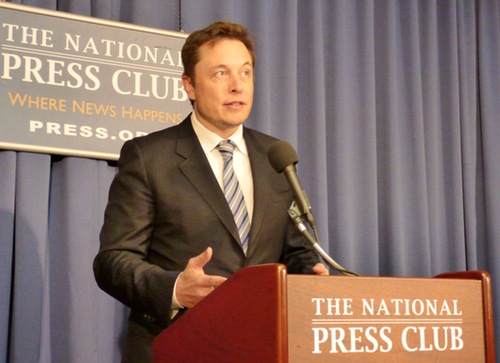
SpaceX CEO Elon Musk speaks at the National Press Club in Washington on April 25. (credit: J. Foust)
On Friday afternoon, SpaceX held a press conference in Washington, organized on short notice (emails went out for the 1 pm EDT press conference a little after midnight), and featuring company CEO Elon Musk. The big news for most was Musk’s announcement that the company was filing suit against the Air Force to protest a “block buy” contract it made with United Launch Alliance (ULA) for EELV-class launch vehicles. Musk, though, also had news about the effort the company made on last Friday’s Falcon 9 launch to land and possibly recover the rocket’s first stage.
“I’m happy to confirm that we were able to land—do a soft landing—of the Falcon 9 boost stage in the Atlantic,” Musk said at the opening of the press conference at the National Press Club, “and all of the data that we received back shows that it did a soft landing and was in a healthy condition after that.”
Musk added that heavy seas in the landing area prevented ships from getting out to the site, and that the stage was destroyed by those rough seas. However, even though SpaceX was not able to recover the booster, he said the data they received was “very clear” that the stage did a vertical, powered “landing” on the ocean surface, and remained upright for at least eight seconds, when telemetry from the stage was cut off. In addition, he said the stage’s landing legs also all deployed as planned.
“I gave it sort of a 40 to 50 percent chance of working,” he said of the landing test. “I was actually pleasantly surprised by the fact that the legs deployed and landed… That’s a better outcome than I had expected.”
Musk did not have any photos or video of the stage’s descent and landing to show at the press conference. He said there was a poor-quality video feed from the stage that the company was trying to clean up; he indicated that the company would post the video on its website in the near future and “crowdsource” efforts to improve its quality.
“This is a really huge milestone for SpaceX and certainly for the space industry,” he said. “No one has ever soft-landed a liquid rocket boost stage before. This bodes very well for achieving reusability.”
SpaceX plans to try this water landing test again on the next Falcon 9 launch, of several ORBCOMM satellites, planned for mid-May from Cape Canaveral. Musk said SpaceX would take several steps to have “a much greater probability” of recovering the stage, including securing much larger boats to help in the recovery effort. The stage would also come down closer to shore on this flight, as the ORBCOMM satellites will go into a different orbit than the International Space Station-bound Dragon spacecraft launched last week.
Musk reiterated previous comments by himself and other company officials that SpaceX hoped to be able to return a stage to land by the end of this year, and perhaps refly that stage next year. He said SpaceX has been in discussions with range officials at Cape Canaveral, identifying several potential sites where the stage could come back. “They’ve actually been really helpful,” he said of the launch site’s range safety staff. “At first we were concerned that range safety might be obstructionists, but they’ve actually been really helpful and supportive.”
Later in the press conference, Musk also appeared to indicate that SpaceX’s preference for a commercial launch site was a site on the Gulf Coast near Brownsville, Texas. “We’re also developing a launch pad on the south coast of Texas, near Brownsville, and we’re waiting on the final environmental approvals for that,” he said. “We’ll probably have that site active in a couple years.”

Leave a Reply